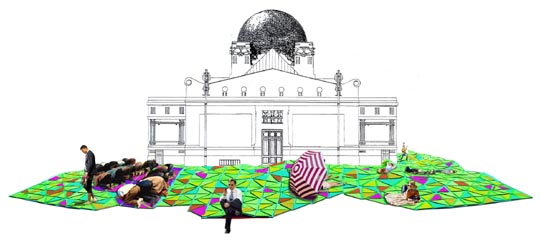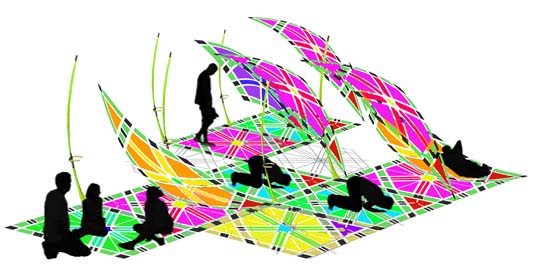Apr 14, 2025
Apr 14, 2025
by Mehru Jaffer
Most of the work of Azra Aksamija, 31, an Austrian artist and architect of Bosnian origin, revolves around the various needs of a cosmopolitan generation of Muslims and the role of Islam in contemporary society.
A survivor of the Bosnian war that claimed a hundred thousand lives between 1992 and 1995 and displaced two million people, Aksamija continues to study the misunderstanding between Muslim and non-Muslim cultures. The ethnic cleansing of Muslims and the massive destruction of their cultural heritage during the war has intensified the claim of Bosnians, like Aksamija, for a national identity and the right to practice their religion without fear.
And Aksamija's art is all about the construction of an identity in relation to being a Muslim, even as she remains an Austrian citizen and works out of Cambridge, USA. In her art, she explores all those elements that enrich the Islamic identity when there is creative interaction between Muslims and their secular surroundings - despite conflict over gender, jurisdiction, politics and globalization.
'Art Mosque', her current exhibition in Vienna, is an attempt to focus on the universal beauty of Islamic culture and aesthetics, an aspect of Islam that has been overshadowed by political Islam, resulting in Islamophobia around Europe.
Her art project is a colorful carpet woven into modular prayer mats and spread over space that is also shared by a construction-site caravan designed and converted by Andreas Straus, an avant garde Austrian artiste, for two other artists to sell luxury sausages.
The co-existence of the 'Art Mosque' beside the 'Sausage Sellers' is an attempt by artists to encourage people to share with each other what is important and sacred to them.

In their work, artists Patrick Baumueller and Severin Hofman deal with everyday activities and often reverse familiar practices. Here, they are looking to supplement their insecure income as artists by creating a lucrative parallel existence as sellers of luxury sausages.
As neighbors of 'Art Mosque', however, they are happy to invent a brand new product - the pork-free sausage - as a result of their consideration for a different eating culture. This way, the artists succeed in preventing a potential conflict on space that is instead transformed into a vibrant place of communication between art audiences and urban public.
In a users' manual meant for visitors, the co-existence of 'Art Mosque' and the 'Sausage Sellers', it is pointed out, has enhanced the dialogue between different religious points of view and social practices: "In order to convey the cultural sensitivity of this topic and to support a constructive dialogue, we ask that all visitors please treat other guests as well as the installations in a respectable manner. The rugs are marked with different colors that are green-blue inside for use as a prayer surface. We ask you to refrain from eating or drinking on the potential prayer rugs and to keep the area clean. Outside it is yellow-red and envisioned for secular use and for the events."

Aksamija exhibits at the Secession, a historic white-cube building from 1897 and home of artists who broke away from the conservatism of art in the Vienna of that time. Today, her art tries to contribute to the creative possibilities of Islamic art outside the confines of tradition that is free of association with a particular place or history. It questions Islamic practices in the context of contemporary Vienna and Muslim life here.
"There is no propaganda in a project like Azra's. She does not say: 'look at me I am not so bad.' Her art is beyond religious issues, transporting religion into the realm of ethics and philosophy," says Barbara Holub, artist, architect and president of the
Secession.
Holub's own work is inspired by current debates in society. She questions norms and behavior routinely accepted and studies both social and personal identities. One of the founders of 'Transparadiso', a collaborative between art, architecture and urbanism, Holub develops projects that transgress borders between urbanism, art and architecture to explore new ways of living in urban areas.
As president of the newly-renovated Secession, she would like to see art step out of museums and archives and address the problems of the day. "The responsibility of artists and architects today is to involve people in issues that matter most in cities," Holub feels.
Before having discovered the 'Art Mosque' project, much concern was expressed at the offices of the Secession over the best way to engage in the ongoing debate over Islam in Austria.
(Austrian history is strewn with instances of Turkish armies that tried to conquer the country several times during the Middle Ages. Besides Turkish immigrants together with Muslims from Bosnia and other parts of the Muslim world now total to about four percent of Austria's 10 million population. Austria is also reluctant to accept Turkey as a full member of the European Union.)
It was decided that one way was to go to the public and to use the open space of the garden on the premises. This way, the Secession attracted many more people, including those not necessarily fond of contemporary art.
"Since the topic was Islam, the television people got interested. Others came for sausages and to listen to music being played by disc jockeys above the 'Sausage Sellers' caravan on some evenings," says a very pleased Holub, making sure that she sits on the red and yellow side of the carpet when she is biting into a sausage or talking, and remembering to flip Aksamija's carpet over to the blue and yellow side when it is time to meditate.
09-Sep-2007
More by : Mehru Jaffer